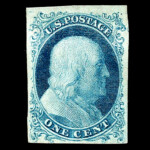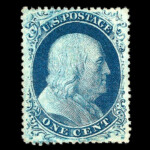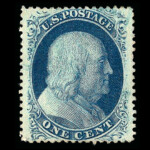The United States Stamp Scott #8 holds a distinct place in philatelic history. It is part of a series introduced following the Congressional act of March 1851, which revised postal rates and necessitated new denominations of postage stamps. This series included the One Cent, Three Cents, and Twelve Cents denominations, each serving specific postal functions. The One Cent stamp, in particular, is noted for its intricate variety of types and subtypes, making it a subject of extensive study and interest in philatelic circles. Its historical significance is underlined by the varied postal uses it was subjected to, along with its existence in several significant varieties.
Design & Print
The contract for printing these new stamps was awarded to Toppan, Carpenter, Casilear & Co., a firm recognized for their printing expertise. The One Cent stamp was produced with a design too large for the plate size, leading to numerous variations in its appearance. The intricate design, coupled with the technical limitations of the period, resulted in a need to trim various outer portions to fit the required 200 impressions on a plate. Over time, new plates were introduced, leading to even more variations. The design, denominated at one cent, featured detailed and elaborate ornamentation, contributing to its distinctiveness among 19th-century U.S. stamps.
Postal Usage
In the context of its postal usage, the One Cent stamp was integral to the U.S. postal system during its time of issuance. It was primarily used for local and low-weight mail, reflecting the postal rate changes enacted in 1851. The stamp underwent changes in its physical characteristics, most notably transitioning from an imperforate issue in 1851 to a perforated issue in 1857. This shift was a response to advancements in postal technology and practices. Additionally, the stamp’s usage was governed by contemporary laws and postal regulations, which influenced its production and circulation.
Identification
Identifying Scott #8 requires a detailed examination of its design features. The stamp is characterized by broken top and bottom lines, with incomplete top and bottom ornaments. Position 99R2 is a notable example, distinguished by its significant double transfer on the right side. Furthermore, the stamp’s classification involves detailed scrutiny of its plate variations, with the imperforate 1851 issue and the perf 15 1857 issue being the primary categories. Within these, further classification is based on design variations, with a focus on the presence or absence of perforations and specific design elements. Identification is further complicated by the existence of the 1875 emission, an officially authorized facsimile, not meant for postal use but often included in expert analyses.
The design variations of Scott #8 are a direct consequence of the initial design being too large for the manufacturing process’s plate size limitations. This resulted in the need to trim certain design elements to fit the required number of impressions on a plate. These design modifications, along with the stamp’s complex, baroque character, are crucial in identifying and classifying the different types of the One Cent stamp.
Scott #8 is a prominent example of 19th-century postal history, distinguished by its design complexity, production challenges, and varied postal usage. Its identification involves a nuanced understanding of its design variations, plate types, and historical context, making it a subject of considerable interest and study in philatelic circles.















































Ask A Question Or Leave A Comment